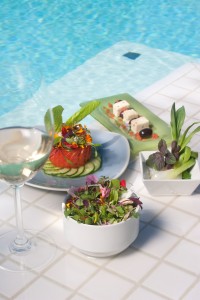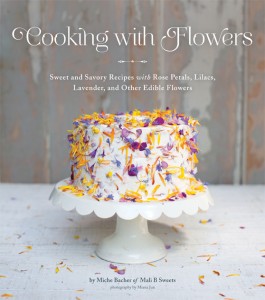
- Lavender Lemonade:
- Lavender lemonade is a refreshing and aromatic twist on classic lemonade, perfect for hot summer days or any time you’re craving a unique and flavorful beverage. Here’s a simple recipe to make lavender lemonade at home:
- Ingredients:
- 1 cup fresh lemon juice (from about 4-6 lemons)
- 6 cups water
- 3/4 cup granulated sugar (adjust to taste)
- 2 tablespoons dried culinary lavender buds
- Ice cubes
- Fresh lavender sprigs and lemon slices for garnish (optional)
- Instructions:
- Make Lavender Simple Syrup:
- In a small saucepan, combine 1 cup of water and granulated sugar over medium heat.
- Stir until the sugar is completely dissolved, creating a simple syrup.
- Add dried lavender buds to the saucepan and bring the mixture to a gentle simmer.
- Let the lavender steep in the syrup for about 5 minutes, then remove the saucepan from heat.
- Allow the lavender simple syrup to cool completely, then strain out the lavender buds using a fine mesh strainer or cheesecloth. Discard the lavender buds.
- Mix Lemonade:
- In a large pitcher, combine the fresh lemon juice, remaining 5 cups of water, and the lavender-infused simple syrup.
- Stir well to combine. Taste and adjust the sweetness by adding more sugar or water if needed.
- Chill:
- Place the pitcher of lavender lemonade in the refrigerator to chill for at least 1-2 hours, allowing the flavors to meld together.
- Serve:
- Fill glasses with ice cubes and pour the chilled lavender lemonade over the ice.
- Optionally, garnish each glass with a sprig of fresh lavender and a slice of lemon for a beautiful presentation.
- Enjoy:
- Stir the lavender lemonade before serving to ensure the flavors are well distributed.
- Sip and enjoy the refreshing and fragrant taste of homemade lavender lemonade!
- Feel free to adjust the sweetness and intensity of the lavender flavor according to your preferences. Lavender lemonade is a delightful beverage that’s sure to impress your guests and provide a cooling respite on a hot day.
Stuffed Zucchini Blossoms

Stuffed zucchini blossoms with rice and ricotta is a delicious and elegant dish that highlights the delicate flavor of zucchini blossoms. Here’s a simple recipe to make this dish:
- Ingredients:
- 12-16 fresh zucchini blossoms
- 1 cup cooked rice (such as Arborio or Jasmine)
- 1 cup ricotta cheese
- 1/4 cup grated Parmesan cheese
- 2 cloves garlic, minced
- 1 tablespoon fresh herbs (such as basil, parsley, or thyme), chopped
- Salt and pepper to taste
- Olive oil for drizzling
- Optional: Marinara sauce for serving
- Instructions:
- Prepare the Zucchini Blossoms:
- Gently rinse the zucchini blossoms under cold water and pat them dry with paper towels.
- Carefully remove the pistil from inside each blossom. Be gentle to avoid tearing the blossoms.
- Prepare the Filling:
- In a mixing bowl, combine the cooked rice, ricotta cheese, grated Parmesan cheese, minced garlic, chopped herbs, salt, and pepper. Mix until well combined.
- Stuff the Blossoms:
- Using a small spoon or piping bag, carefully fill each zucchini blossom with the rice and ricotta mixture. Be gentle to avoid tearing the blossoms.
- Seal the Blossoms:
- Gently twist the petals of each stuffed blossom to seal in the filling. This will help keep the filling inside during cooking.
- Cook the Stuffed Blossoms:
- Preheat your oven to 375°F (190°C).
- Place the stuffed zucchini blossoms on a baking sheet lined with parchment paper.
- Drizzle the blossoms with olive oil and sprinkle with salt and pepper.
- Bake in the preheated oven for 15-20 minutes, or until the blossoms are tender and the filling is heated through.
- Serve:
- Once cooked, transfer the stuffed zucchini blossoms to a serving platter.
- Serve hot, optionally with marinara sauce on the side for dipping.
- Enjoy these delicious stuffed zucchini blossoms with rice and ricotta as an appetizer or a light main course. They make a beautiful and flavorful dish that’s perfect for showcasing the bounty of the season!
Edible Flower Soup

Creating an edible flower soup can be a unique and visually stunning culinary experience. Here’s a recipe to guide you through making a delicious and beautiful edible flower soup:
Ingredients:
- 4 cups vegetable broth (homemade or store-bought)
- 1 onion, finely chopped
- 2 cloves garlic, minced
- 2 tablespoons olive oil
- 1 medium potato, peeled and diced
- 1 cup mixed edible flowers (such as nasturtiums, violets, pansies, or rose petals), washed and dried
- 1/2 cup heavy cream (optional)
- Salt and pepper to taste
- Edible flower petals and fresh herbs for garnish
Instructions:
- Prepare the Soup Base:
- In a large pot, heat the olive oil over medium heat. Add the chopped onion and minced garlic, and sauté until soft and translucent, about 5 minutes.
- Add the diced potato to the pot and cook for another 3-4 minutes, stirring occasionally.
- Add Broth and Simmer:
- Pour the vegetable broth into the pot with the onion, garlic, and potato. Bring the mixture to a simmer over medium heat.
- Reduce the heat to low, cover the pot, and let the soup simmer for about 15-20 minutes, or until the potato is tender and cooked through.
- Blend the Soup:
- Once the potato is cooked, use an immersion blender or transfer the soup to a blender (in batches if necessary) to puree until smooth and creamy.
- Return the pureed soup to the pot if using a blender.
- Add Edible Flowers:
- Gently fold in the mixed edible flowers into the pureed soup. Reserve some flowers for garnish if desired.
- Allow the soup to simmer for an additional 2-3 minutes to infuse the flavors of the flowers into the soup.
- Finish with Cream (Optional):
- If using heavy cream, stir it into the soup until well combined. This will add richness and creaminess to the soup, but it can be omitted for a lighter version.
- Season and Serve:
- Taste the soup and season with salt and pepper to your liking.
- Ladle the edible flower soup into bowls and garnish with additional edible flower petals and fresh herbs for a beautiful presentation.
- Enjoy:
- Serve the edible flower soup immediately while hot. Enjoy the delicate flavors and vibrant colors of this unique and delightful dish!
This edible flower soup is not only delicious but also a feast for the eyes. It’s perfect for special occasions or whenever you want to impress your guests with a visually stunning and flavorful dish.
These recipes are just a starting point, feel free to get creative and incorporate edible flowers into your favorite dishes!

 I know you are reading this thinking, “I thought flowers were only to be looked at and enjoyed visually!” Not true. In fact, you can eat them too. And for the most part edible flowers are low in (or free of) calories, cholesterol and fat. Edible flowers have been used as food for thousands of years.
I know you are reading this thinking, “I thought flowers were only to be looked at and enjoyed visually!” Not true. In fact, you can eat them too. And for the most part edible flowers are low in (or free of) calories, cholesterol and fat. Edible flowers have been used as food for thousands of years.


